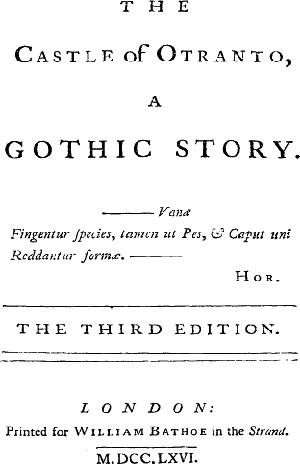John Keats, selected poems Contents
The Gothic
Reactions against rationality
As well as the development of Romanticism, the reaction to rationality also found expression in sentimental and Gothic literature.
Sentimentalism
‘Sentimentalism' developed as a reaction to rationalism in philosophy and to Calvinism in religion. Whereas the Enlightenment encouraged distrust of feelings, and Calvinism taught that the human heart was intrinsically evil, Sentimentalism emphasised the central importance of feelings and the essential goodness of the human heart.
A Sentimental approach can be found in novels like Sir Charles Grandison by Samuel Richardson. It is also highlighted in the debate between reason and sentiment in Jane Austen's Sense and Sensibility.
Gothic literature
Of far greater influence on Keats was the genre of the Gothic novel. The term Gothic denoted a time that was barbaric, disordered, irregular – before the Enlightenment and the scientific revolution. In reaction to an emphasis on reason, Gothic texts represent a world that is not totally controlled by, and accessible to, human rationality. It is aware of deeper psychological and sexual impulses beyond the realm of reason. (See Aspects of literature > Aspects of the gothic.)
 The widespread taste of the Gothic grew from the mid-eighteenth century onwards and was a reaction against the symmetries of neo-classical form and design. Although it began as a trend in architecture, it soon became associated with literature, in particular the novel, and it was the publication in 1764 of Horace Walpole’s The Castle of Otranto, set in eleventh century Spain, that initiated a craze for narratives full of dark deeds and supernatural events set in sinister castles.
The widespread taste of the Gothic grew from the mid-eighteenth century onwards and was a reaction against the symmetries of neo-classical form and design. Although it began as a trend in architecture, it soon became associated with literature, in particular the novel, and it was the publication in 1764 of Horace Walpole’s The Castle of Otranto, set in eleventh century Spain, that initiated a craze for narratives full of dark deeds and supernatural events set in sinister castles. Otranto’s aristocratic villain Manfred, the persecuted heroine Isabella and its various dungeons, hidden doors and spooky tunnels may seem like clichés for a modern reader, but they seemed very new and exciting to contemporary readers who demanded more stories like this. Soon other writers such as Clara Reeve, William Beckford, Matthew Lewis, Anne Radcliffe, William Godwin, Charles Maturin and Mary Shelley were producing novels in the same genre.
The Gothic and Keats
Elements of the Gothic were not confined to the novel. It encompassed drama and poetry as well. Keats’ poem The Eve of St Agnes, with its setting on a freezing winter evening in a medieval mansion in the distant past, has many Gothic elements, as do:
- Isabella: or The Pot of Basil
- Lamia
- Endymion
- La Belle Dame Sans Merci.
In English Literature, it denotes a period between 1785-1830, when the previous classical or enlightenment traditions and values were overthrown, and a freer, more individual mode of writing emerged.
1. A style of fiction evoking mystery and terror. 2. Connected with or characteristic of the Middle Ages. 3. Style of architecture current in Western Europe from the 12th century to the 16th century, characterised by the pointed arch. 4. Relating to
The system of belief taught by John Calvin, a French Reformation scholar and translator working from Geneva in the 1500's.
A European intellectual movement of the seventeenth and eighteenth centuries, also known as the Age of Reason. It sought to promote knowledge and reform society by focussing on what could be understood through reason and logic.
Frequently used expressions which are therefore unoriginal and unimaginative.
English writer most noted for her first novel Frankenstein.
Recently Viewed
Scan and go
Scan on your mobile for direct link.